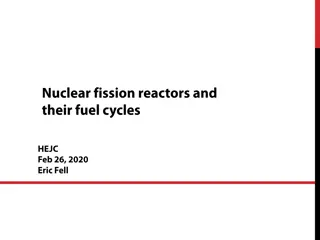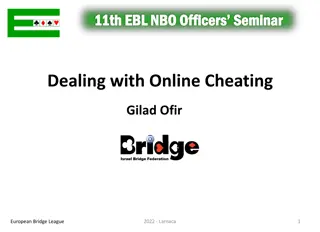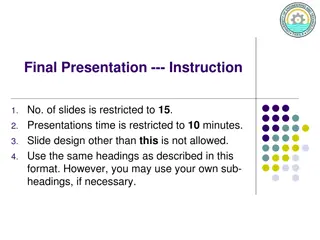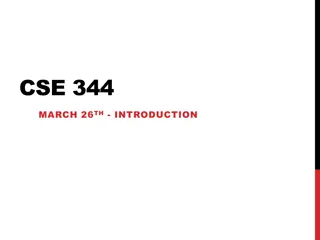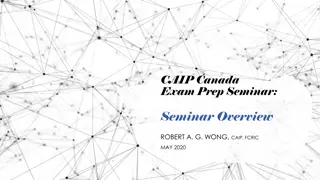
Understanding Expectimax Search: Uncertainty in Game AI
Discover the concept of Expectimax search in game AI, where uncertainty plays a key role in decision-making. Explore how average-case outcomes are considered over worst-case scenarios, and how to calculate expected utilities in game nodes with uncertain outcomes.
Download Presentation

Please find below an Image/Link to download the presentation.
The content on the website is provided AS IS for your information and personal use only. It may not be sold, licensed, or shared on other websites without obtaining consent from the author. If you encounter any issues during the download, it is possible that the publisher has removed the file from their server.
You are allowed to download the files provided on this website for personal or commercial use, subject to the condition that they are used lawfully. All files are the property of their respective owners.
The content on the website is provided AS IS for your information and personal use only. It may not be sold, licensed, or shared on other websites without obtaining consent from the author.
E N D
Presentation Transcript
EXPECTIMAX SEARCH By:- Jaswanth Gorthi Abhay Sharma Rahul Ratneshwar Mandal
In solitaire, next card is unknown Uncertain Outcomes In minesweeper, mine locations In pacman, the ghosts act randomly
The expected value of a function of a random variable is the average, weighted by the probability distribution over outcomes How long to get to the airport? Probability of being no traffic, traffic and heavy traffic are 25%, 50% and 25% respectively Expectation 20 min 30 min x 60 min x Time: + + 35 min x 0.50 0.25 Probability: 0.25
Expectimax Search Max Values should now reflect average-case (expectimax) outcomes, not worst-case (minimax) outcomes. Chance Expectimax search: compute the average score under optimal play. Max nodes as in minimax search Chance nodes are like min nodes but the outcome is uncertain Calculate their expected utilities I.e. take weighted average (expectation) of children 9 10 100 10
The other node is not adversarial, also not in your control. we just do not know what is going to happen. Using expectimax is not 100% safe, you might loose. Usually chance nodes are governed by probabilities (instead of just selecting min) and average is weighted by those probabilities. In many games the probability is uniform, flipping a coin, rolling a dice. In real world probabilities governing outcome reflects our knowledge and expectations about the world problems. Properties of Expectimax
def value(state): if the state is a terminal state: return the state s utility if the next agent is MAX: return max-value(state) if the next agent is EXP: return exp-value(state) Expectimax Pseudocode
def max-value(state): initialize v = - for each successor of state: v = max(v, value(successor)) return v def exp-value(state): initialize v = 0 for each successor of state: p = probability(successor) v += p * value(successor) return v
Calculating Expectation def exp-value(state): initialize v = 0 for each successor of state: p = probability(successor) v += p * value(successor) return v 1/6 1/2 1/3 8 24 -12
Calculating Expectation def exp-value(state): initialize v = 0 for each successor of state: p = probability(successor) v += p * value(successor) return v 1/6 1/2 1/3 8 24 -12 v = (1/2) (8) + (1/3) (24) + (1/6) (-12) = 10
Expectimax Example 3 12 9 2 4 6 15 6 0
Expectimax Example 8 3 12 9 2 4 6 15 6 0
Expectimax Example 8 4 3 12 9 2 4 6 15 6 0
Expectimax Example 8 4 7 3 12 9 2 4 6 15 6 0
Expectimax Example 8 8 4 7 3 12 9 2 4 6 15 6 0
Depth-Limited Expectimax Estimate of true expectimax value (which would require a lot of work to compute) 400 300 492 362
Mixed Layer Types Expectiminimax Environment is an extra random agent player that moves after each min/max agent Each node computes the appropriate combination of its children E.g. Backgammon
ExpectiMinimax-Value(state ) : Expectiminimax Pseudocode
Utilities are functions from outcomes (states of the world) to real numbers that describe an agent s preferences Where do utilities come from? Utilities In a game, may be simple (+1/-1) Utilities summarize the agent s goals Theorem: any rational preferences can be summarized as a utility function
Utilities: Uncertain Outcomes
Maximum Expected Utility Why should we average utilities? Why not minimax? Principle of maximum expected utility (MEU) : A rational agent should choose the action which maximizes its expected utility, given its knowledge
x2 20 30 400 900 0 40 0 1600 What Utilities to Use? For worst-case minimax reasoning, terminal function scale doesn t matter We just want better states to have higher evaluations (get the ordering right) We call this insensitivity to monotonic transformations For average-case expectimax reasoning, we need magnitudes to be meaningful
Dice rolls increase b: 21 possible rolls with 2 dice Backgammon 20 legal moves As depth increases, probability of reaching a given search node shrinks So usefulness of search is diminished So limiting depth is less damaging Backgammon Historic AI: TDGammon uses depth-2 search + very good evaluation function + reinforcement learning: world-champion level play 1st AI world champion in any game!
Can we apply pruning in expectimax search? What is the time complexity of expectimax search algorithm? Questions Can we apply pruning in expectiminimax search?
Expectimax Pruning 2 3 12 9
There is no pruning for expectimax There is no concept of optimal play by adversary, it is just unknown Expectimax Pruning No matter what you have seen so far, the content of unexplored children could change expectimax value remarkably .Thus, expectimax is slow. Strategies exist to speed up
We would like to thank Dan Klein(University of California, Berkeley)for their slides and for sharing his knowledge on this topic through youtube videos References: Bibliography https://www.youtube.com/watch?feature=player_embedded&v= GevK0-9n24g



